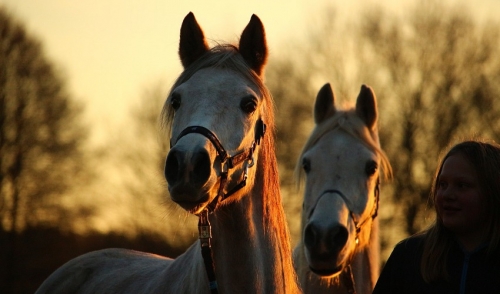{article.name}
Stay Informed
Riding into the Sunset: Ways to Keep Your Senior Horse Active

- Share this:
- Share on Facebook
- Pin on Pinterest
- Tweet on Twitter
As your horse reaches his or her late teens, they may lose some of the sprightliness it showed in its earlier years. The key to keeping your senior horse active is just that: focus on keeping up with consistent exercise, though you may need to reduce the pace and challenge of daily workouts. Below are five tips to guide you through this shift:
1. Stay attuned to your horse. Keep watch for signs of lameness (uneven stride, dragging a toe, or shifting weight off of a front hoof in resting position). If you notice these signs, refrain from masking any lameness with pain medication and consult your vet.
You may notice a shortened stride, signaling that your horse is sore. This may come with a shift towards a stubborn or resistant personality; your horse may pin back his ears and flick his tail as you try to open his stride.
2. Condition in intervals. You may need to get your horse back into shape after a period of little to no activity. This is most effectively done through interval training. Start training with a series of long walks on even ground (2-4 miles). These walks may take over a month to build necessary muscle tone. Continue building strength by slowly adding hills to the regimen. Again, this is best done in intervals, with two or three days of hills and the remainder spent in brisk walks. The next interval to introduce is two to five minute stretches of trotting, or, if your horse is up for it, cantering.
3. Maintain consistency. It is easy to practice interval training in warm months, with opportunities for trail walks and hacking. However, don’t let winter give rise to zero activity. It will be much harder to bring your horse back up to shape the longer you let her rest in the winter. Make sure you reserve at least ten minutes for a brisk walk to warm up your horse’s joints and loosen muscles.
4. Focus on exercise and conditioning, rather than skills training. Older horses have had more time to rehearse certain skills, so it is not necessary to keep up with constant practice if your horse is still showing. Take a week during show season for tune-up, but make sure your horse, and not the sport, is your number one priority.
Some riders make the mistake of resting their horses before shows to prevent soreness. This will only serve to make your horse more stiff; lessen the number of shows you participate in if you must, but keep exercise constant.
5. Have patience and consult the experts! When in doubt, consult your vet and farrier. If it is time to stop showing, they will keep you in check. Keeping an old friend into his or her senior years is a blessing, though your relationship with your horse may change. Keep active and enjoy that ride into the sunset years!
Special Offers


Comments